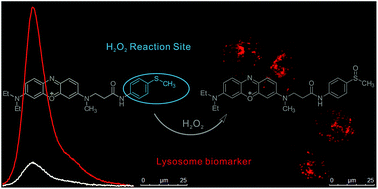Near-infrared and lysosome-targetable fluorescent probe based on phenoxazinium for hydrogen peroxide detection†
Abstract
A new near-infrared and lysosome-targetable fluorescent probe based on phenoxazinium was designed and prepared for hydrogen peroxide detection. This probe used phenoxazinium as the fluorophore acceptor and a methyl(phenyl)sulfane unit as the recognition group through a photoinduced electron transfer mechanism. With the addition of H2O2, the methyl(phenyl)sulfane unit of the probe was oxidized to a sulfoxide unit, causing enhanced fluorescence intensity at 676 nm due to the inhibition of photoinduced electron transfer. This probe not only showed competitive sensitivity, good selectivity, and a relatively fast response time, but also selectively targeted lysosomes of HeLa cells, indicating that it could be applied to detecting and visualizing H2O2 in HeLa cell lysosomes.

- This article is part of the themed collection: Analytical Methods Recent HOT articles


 Please wait while we load your content...
Please wait while we load your content...